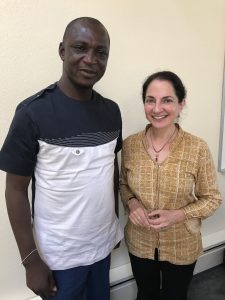This was a line from Joe Bock’s lecture on “The Positive Role of Religion in Peacebuilding”. Joe shared with us his experiences working in conflict zones, refugee camps and for Catholic Services in Israel/Palestine. He noted that religious conflict is often not about theology or belief systems but identity. Religious groups are places of belonging. They can bring out the best in humanity, and they can bring out the worst. When in conflict, we are at our best if we can peer through windows of interpretation together, seeing a way forward for healing. Communities able to peer together across difference will ultimately be the most important solution for the brokenness in which they find themselves.
Joe spoke of religion as “the two-edged sword of love that is like butter on the one hand and sharpness like hate on the other.” Surely this is true. Hate makes the news more than love. It can excite us positively and negatively. How strange that the quality of the universe we say we most long for is the one we least publicize. To kill, to rape, to slaughter with words or weapon, a signature implementing an unjust policy for the already disadvantaged takes moments and does irreparable damage. Patterns of love – that cut smooth like butter – takes a lifetime. This work is never done. There will always be millions more in need of it.
To find mutuality amidst difference, to look for windows of interpretation and understanding through which people of diverse groups can together peer, is to build relationships across difference. Deepening relationships, humanizing the other, can create common ground for Peacebuilding.
Religion is often the cause or at least exacerbates the world’s problems, but also hold tools and remedies for solutions. Elizabeth Cole picked up in her lectures Wednesday and Thursday on Reconciliation. Although not owned by the world of religion, religion was a perfect follow-on to Joe’s offering.
We have spoken much in our course about the systemic realities of violence, the long-term, destructive implications of conflict, and tools for implementing peace at various stages of conflict. Real reconciliation- the change-of-heart-kind – where all parties end up moving to a new place, disciplining themselves to love and respect in word and deed; this is elusive for many around the globe. We often fail, post-war, managing at best to get to tolerance. Peace is always fragile and requires tending. In my world of faith, reconciliation, where one seeks to live deeply into the butter side of the sword, is always the goal, even if it is not attained.
In The Hebrew Bible, the iconic story of Jews (and the budding nation of Israel) leaving slavery in Egypt and journeying to “The Promised Land” is a core, paradigmatic story of what it is to always be in process of reaching this land of perfection and harmony. Moses dies after a lifetime of leading a people to it, seeing it – just off in the distance. Hebrew Bible scholars will say that it is in the journey that we find our deepest peace, our deepest communion with God and with one another. The minute we think we reach it, is when we lose it. Peace is always fragile but no more so than when we think we have perfected it.





